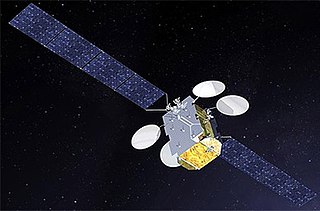
Hot Bird is a group of satellites operated by Eutelsat, located at 13°E over the equator and with a transmitting footprint over Asia, Europe, North Africa, Americas and the Middle East.

Spacebus is a satellite bus produced at the Cannes Mandelieu Space Center in France by Thales Alenia Space. Spacebuses are typically used for geostationary communications satellites, and seventy-four have been launched since development started in the 1980s. Spacebus was originally produced by Aérospatiale and later passed to Alcatel Alenia Space. In 2006, it was sold to Thales Group as Thales Alenia Space.
Eutelsat 133 West A is a Eutelsat operated Eurobird satellite, used primarily for digital television. It was launched in March 2001, and after a short period testing at 33°E, joined Eutelsat 2F4 at 28.5°E in the Clarke Belt, just within the range of satellite dishes pointed at SES' Astra 2 satellites at 28.2° east. It moved to 33° east and joined Eutelsat 33B in July 2015. Then it was moved to 133° west.
JCSAT-5A or N-STAR d, known as JCSAT-9 before launch, is a geostationary communications satellite operated by SKY Perfect JSAT Group (JSAT), which was designed and manufactured by Lockheed Martin on the A2100 platform.

The Arab Satellite Communications Organization is a communications satellite operator in the Arab World, headquartered in the city of Riyadh, Saudi Arabia. Arabsat was created to deliver satellite-based, public and private telecommunications services to the Arab States, in accordance with International Standards. With 21 member countries, the organization plays a vital role of enhancing communications in the Arab World.
The Intelsat VI series of satellites were the 8th generation of geostationary communications satellites for the Intelsat Corporation. Designed and built by Hughes Aircraft Company (HAC) in 1983-1991, there were five VI-series satellites built: 601, 602, 603, 604, and 605.
Eutelsat 36A is a French communications satellite operated by Eutelsat Communications. It was constructed by Alcatel Space and is based on the Spacebus-3000B2 satellite bus.
Eutelsat 4A, previously Eurobird 4A and Eutelsat W1 is a French communications satellite which is operated by Eutelsat. It was constructed by Astrium is based on the Eurostar-2000+ satellite bus. Its launch was contracted by Arianespace, using an Ariane 4 44P-3 carrier rocket. The launch occurred on 6 September 2000, at 22:33 UTC from ELA-2 at the Guiana Space Centre.
Eutelsat 36B is a communications satellite in the W series operated by Eutelsat. It is co-located with Eutelsat 36A satellite at 36° East. It was launched on 24 November 2009, at 14:19:10 UTC, by a Proton launch vehicle.
Eutelsat 21B, previously known as Eutelsat W6A, is a French communications satellite. Operated by Eutelsat, it provides direct to home broadcasting services from geostationary orbit at a longitude of 21.5 degrees east. It replaced the Eutelsat 21A spacecraft which was launched in 1999.
Eutelsat 70B is a commercial communications satellite run by Eutelsat. It was launched on 3 December 2012 and is designed to provide telecommunication services for the Middle East, Central Asia, South East Asia and parts of Africa. It will replace Eutelsat 70A, which was previously known as Eutelsat W5. That satellite, which was launched in 2002, currently occupies the same 70.5° E location this satellite is intended for.
Eutelsat 3D is a communications satellite operated by Eutelsat, provides services to Europe, North Africa, the Middle East and Central Asia. It initially was located at 3° E in geosynchronous orbit in a fixed point above the equator, where Eutelsat already has two satellites, Eutelsat 3A and Eutelsat 3C. When Eutelsat 3B was launched in 2014 this satellite was moved to 7°E.
Eutelsat 8 West C, known as Hot Bird 6 prior to 2012 and Hot Bird 13A from 2012 to 2013, is a geostationary communications satellite. Operated by Eutelsat, it provides direct-to-home (DTH) broadcasting services from geostationary orbit. The satellite was part of Eutelsat's Hot Bird constellation at a longitude of 13° East, until it was relocated to 8° West between July 2013 and August 2013.
Superbird-A2, known as Superbird-6 before launch, was a geostationary communications satellite ordered and operated by Space Communications Corporation (SCC) that was designed and manufactured by Hughes on the BSS-601 satellite bus. It had a mixed Ku-band and Ka-band payload and was expected replace Superbird-A at the position at 158° East longitude. It was expected to provided television signals and business communications services throughout Japan, South Asia, East Asia, and Hawaii.
JCSAT-2A, known as JCSAT-8 before launch, is a geostationary communications satellite operated by SKY Perfect JSAT Group (JSAT) which was designed and manufactured by Boeing Satellite Systems on the BSS-601 platform. It has Ku-band and C-band payload and was used to replace JCSAT-2 at the 154° East longitude. It covers Japan, East Asia, Australia and Hawaii.
Intelsat IV F-3 was a geostationary communication satellite built by Hughes and owned by Intelsat. The satellite was based on the HS-353 platform and its estimated useful life was 7 years.

Intelsat IVA F-1 was a geostationary communication satellite built by Hughes, it was owned by Intelsat. The satellite was based on the HS-353 platform and its estimated useful life was 7 years.

Intelsat IVA F-4 was a geostationary communication satellite built by Hughes. It was owned by Intelsat.

Intelsat IVA F-5 was a geostationary communication satellite built by Hughes, it was owned by Intelsat. The satellite was based on the HS-353 platform and its estimated useful life was 7 years. However, the satellite was destroyed in a launch failure.

Eutelsat Konnect is a geostationary communications satellite operated by Eutelsat. The satellite was designed and manufactured by Thales Alenia Space on the Spacebus NEO 100 platform, and was launched on 16 January 2020 on an Ariane 5 ECA. The satellite provides broadband internet and communications coverage to Europe and Sub-Saharan Africa.




